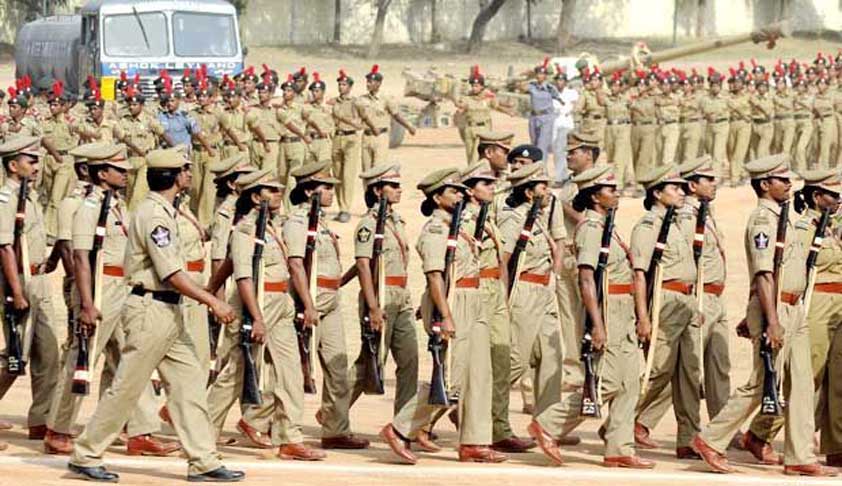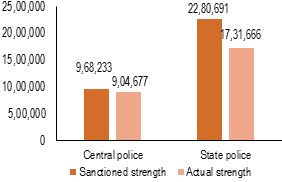Police Brutality and the need for Police Reforms

The Police system in India and its sorry state once again came to the fore recently when a father-Son duo, namely P Jeyaraj (58) and Fenix (31) respectively, died in Police custody in Tamil Nadu. The relatives and protestors fear this to be a case of police brutality. The reason for their arrest was that they kept their shop open beyond permitted time (restrictions placed in the light of COVID-19). This comes amid the cases of police brutality across the country and the recent uproar over the George Floyd case.
This topic of “Police Brutality and the need for Police Reforms” is important from the perspective of the UPSC IAS Examination, which falls under General Studies Portion.
What is police brutality?
- The term “police brutality” is sometimes used to refer to various human rights violations by police including beatings, racial abuse (caste/religious abuse mostly in case of India), unlawful killings, torture, or indiscriminate use of riot control measures at protests.
- This term is used when the police force uses undue or excessive or extra-legal force against a subject.
- Police brutality is a worldwide phenomenon including racial abuse for centuries in the USA, Britain, and continental European countries where protests have been dealt with brutal force.
- The developing world is infamous for police excesses during protests or otherwise.
- In India too, police forces are infamous for “Third degree”, custodial deaths, inactivity due to excessive political subordination.
Why Police brutality is a human rights violation?
- At its worst, police brutality could lead to people being deprived of the right to life.
- In general, police brutality leads to violation of the right to freedom, illegal police custody, physical and mental abuse, violation of legal protections against torture, etc.
What are the causes of Police Brutality in India?
- Police force in India still follows the colonial legacy of being a force that must be feared by the common public. The feudal relationship between the police and citizen continues.
- The police force is still governed by archaic law, the Police Act, 1861. Apart from the law, other governing statutes are the Indian Penal Code, 1862, the Indian Evidence Act, 1872, and the Criminal Procedure Code of 1973. These archaic laws are laws of a police state whose original intent was of maintaining a law and order to protect interests of a colonial government and its exploitation.
- Unscientific criminal investigation techniques and lack of training in Human rights lead to inhuman techniques of investigation like the third degree which consists of hammering iron nails in the body, beating the soles of the feet, stretching apart the legs in opposite direction, hitting private part and other draconian acts.
- Excessive political control makes it impossible to work independently and politically charged abuses often happen by orders of political masters. The handling of protests over the Citizenship Amendment Act and violence in JNU and Jamia Milia Islamia University is a case in point.
- This is helped by the posting, transfer, and promotion of police officials is under political control which helps in quid-pro-quo and police-bureaucratic-political nexus.
- The social structure of India penetrates every institution including the police force. The societal prejudices based on caste, religion, ethnicity, language, region are part of police personnel and the abuses also represent a trend based on these biases.
- The police force is thinly manned in India. The police-population ratio, currently 144 policemen per lakh population, is less than what is recommended by the UN i.e. 222. The burden of workload poses serious psychological issues among police, which results either into either brutality towards inmates or self-harm.
- According to a national survey of 2014, 90% of officers work longer than eight hours a day, and 73% got no more than one day off per week.
- Even during the COVID-19 pandemic, the police brutality came to the fore when various incidences of ridiculous punishments inflicted upon violators of lockdown.
- Popular media and entertainment industry popularize and glorify police brutality. The common people also deem the police violence necessary to keep criminals in check.
What is the status of police excesses in India?
- According to the Ministry of Home Affairs’ answer to the Rajya Sabha, 427 people died in police custody between 2016 and 2019.
- If judicial custodial deaths are also considered 5476 people have died in custody over the past three years.
- In 2017, only three states, Andhra Pradesh, Maharashtra, and Gujarat reported more than half of all custodial deaths.
- In 2018, the research institute Centre for the Study of Developing Societies (CSDS) found that less than 25% of Indians trusted the police.
- The status of Police report, 2019 by Common Cause, a civil society organization says that three out of every four personnel believe that the police are justified in being violent towards criminals. Four out of five respondents feel that there is nothing wrong with beating up criminals to extract confessions if it helps in conviction.
History for Police reforms
- From the above discussion, it becomes clear that there is a serious need to reform the police system to make it more people-friendly, independent, sensitive, and easy to work at.
- Police and public order is a state subject. Hence police force in a state comes under the state government.
- So, maintaining public order, police and prisons come under state and protection of states from external and internal security challenges, deployment of central police forces, Institutes for intelligence, investigation, and police training comes under the Union government.
- The Second Administrative Reforms Commission has noted that the political control is abused by the political executive.
- Post-independence, the first Police Reforms Committee was set up by Kerala in 1959. This was followed by a succession of Police Commissions appointed by different State Governments mainly during the sixties and seventies.
- This was followed by the setting up of the Gore Committee on Police Training in 1971 and subsequently the National Police Commission in 1977 which suggested reforms in the existing police set-up and also a Model Police Act.
- The National Police Commission, in its first report (1979), recommended a judicial inquiry in all cases where two or more persons had died in police firing for dispersal of an unlawful assembly.
- Major recommendations by the National Police Commission were not adopted by any government.
- Two former Director Generals of Police (DGPs) filed a Public Interest Litigation (PIL) in the Supreme Court (Prakash Singh Vs. Union of India) in 1996 asking the Court to direct governments to implement the NPC recommendations.
- While the matter was underway in the SC, the Ministry of Home Affairs set up the Padmanabhaiah Committee in 2000 to examine the needs of policing in the new millennium.
- In 2006, the SC gave a landmark judgment in the Prakash Singh case with seven directions (six for the state government and one for the Union) to reform police forces across the country and constituted the Soli Sorabjee Committee which then suggested a Model Police Act.
What are the Supreme Court directives in the Prakash Singh case?
The apex court gave its revolutionary directions in 2006 in which the states and Union territories were directed to comply with seven directives which are as follows
- Constitution of State Security Commission (SSC) to
- Ensure that state governments do not exercise undue influence or pressure on the police.
- Laying down the broad policy guidelines.
- Performance evaluation of the state police
- Independence of Director General of Police (DGP)
- The DGP and other key officials should be provided with the minimum tenure of two years.
- The DGP should be appointed from amongst three senior-most officers who have been empanelled for the promotion by the UPSC. The basis of empanelment will be length of service, good record, and experience.
- Ensuring that other police officers on operational duties (including SP in-charge of a District and Station House officers-in-charge of a police station) are also provided with a minimum of two years of tenure.
- Police Establishment Board (PEB)
Setting up PEB to decide transfers, postings, and promotions of and below the rank of Deputy Superintendent of Police (Dy SP) and make recommendations on posting and transfer above the rank of Dy SP.
- Separation of investigation and law and order functions of the police.
- Police Complaints Authority (PCA)
Setting up of PCA
- At the state level to inquire into public complaints against police officers of and above the rank of Deputy Superintendent of Police in cases of a) serious misconduct, b) custodial death c) grievous hurt d) rape in police custody
- At district levels to inquire into public complaints against the police personnel below the rank of Deputy Superintendent of Police in cases of serious misconduct
- National Security Commission (NSC)
Setting up of NSC at the Union level to prepare a panel for selection and placement of Chiefs of the Central Police Organisations (CPO). They will have a minimum tenure of two years.
What has been the status of compliance of the SC directives?
- In the last 14 years after the directives were given, there is not a single state that has fully complied with the directives. The Court is still waiting for state compliance and the Monitoring Committee is still examining the state’s compliance.
- After studying the report of Justice Thomas Committee on state compliance in 2010, the Court sent show-cause notices to the four states- Karnataka, Maharashtra, Uttar Pradesh, and West Bengal for non-compliance.
- Many states have devised their own means to dilute and sabotage the intent of the directives.
- The last year’s controversy over the CBI chief post showcases that the political will is not only unwilling but it overtly disregards well-intended reforms in police administration.
- The DGPs are still transferred, removed from the post before completing two years.
- Seventeen States have established the PCAs but according to the Commonwealth Human Rights Initiative (CHRI), the PCAs have only remained on paper.
- Justice Thomas Committee in its report (2010) expressed disappointment over the indifference to the issue of police reforms exhibited by the states.
- Justice JS Verma Committee urged all states to comply with all the six Supreme Court directives in order to tackle systemic problems in policing.
Recent Government actions
- In 2017, the Government of India approved a Rs 25,000-crore internal security scheme to strengthen the law and order system, state police forces modernization and enhance their capacity to combat terrorism. The umbrella scheme of the Modernisation of Police Forces (MPF), was to be implemented between 2017 and 2020.
- The scheme has provisions for women’s security, mobility of police forces, up-gradation of police wireless, satellite communications, logistical support, hiring of helicopters, crime and criminal tracking network and systems (CCTNS).
- The prime minister enunciated the concept of SMART Police in 2014- S-strict and sensitive, M-modern and mobile, A-alert and accountable, R-reliable and responsible, T-tech-savvy and trained.
Way forward
- The political section must show the political will necessary to bring the necessary changes in the police structure.
- The Model Police Act of 2015 can be the basis for legislative reform as it seeks to modernize the structure and mandate of the Police, protect it from excessive political interference and assessment of police performance.
- States should be encouraged and appropriately incentivized to implement provisions of the Prakash Singh directives and Model Police Act. The 15th Finance Commission term of reference to award state based on the implementation of some central sector schemes can include Police reforms in it.
- The PM’s SMART police initiative must see some kind of implementation as it is based on the noble concept of community policing.
- What we have today is the Ruler’s Police. What we need is the People’s Police.
- The police have, with fair justification, have been accused of being insensitive to the poor and tribals. This should be eliminated through pre-service training, mid-career sensitivity training to the police forces.
- Technology up-gradation and cyber strength would be of great help but bereft of sensitivity and accountability to the people, its gains would be limited.
- It is time that the legislators to bring police and public order in the Concurrent List of Schedule VII of the Constitution. Various Constitutional experts like Fali S. Nariman have strongly spoken in favor of the amendment.
Conclusion
We take great pride in India being one of the fastest-growing economies. However, we are ignoring a simple truth that sustained economic progress needs the foundation of good law and order, and we cannot have good law and order in the country without police reforms. Cosmetic improvements will not help but reforms of a fundamental nature are necessary. The colonial police must be replaced with the welfare state notion of policing. We must have a Police force committed to giving security to the people, upholding the human rights of all sections, being fair to the minorities and sensitive to the poor and tribal, and above all upholding the rule of law.
Practice Question for Mains
Police structure in India still represents a colonial idea of Police state. explain the need for police reforms and suggest recommendations for reforms. (250 words)
https://niti.gov.in/writereaddata/files/document_publication/Strengthening-Police-Force.pdf
https://www.prsindia.org/policy/discussion-papers/police-reforms-india
https://frontline.thehindu.com/dispatches/article28960801.ece
https://scroll.in/article/964820/what-can-india-do-to-combat-police-brutality-and-bias
https://www.polemicsnpedantics.com/single-post/2018/06/11/Police-Brutality-and-Reform-in-India
https://qz.com/india/1826387/indias-coronavirus-lockdown-brings-police-brutality-to-the-fore/
https://www.bbc.com/news/world-asia-india-53202707
https://indianexpress.com/article/opinion/coronavirus-india-lockdown-police-6396636/
https://www.amnesty.org/en/what-we-do/police-brutality/
https://scroll.in/article/964820/what-can-india-do-to-combat-police-brutality-and-bias




